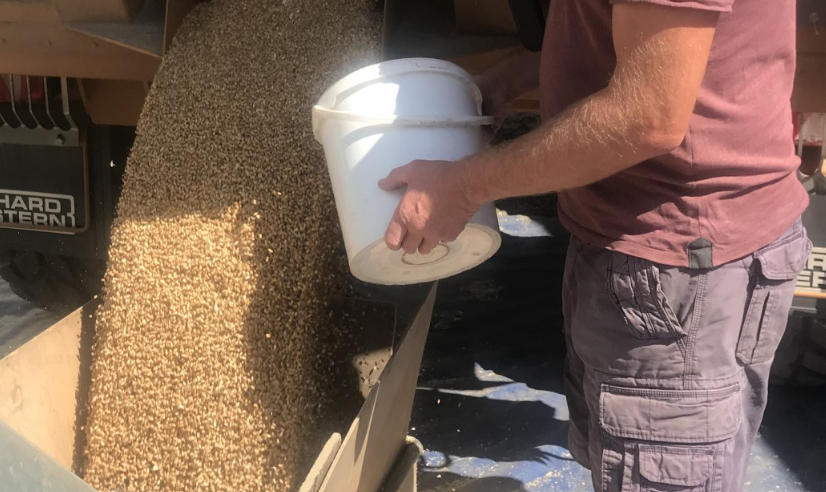GrainCheck Analysis #2: Taking the best grain samples for insightful results

Blog by Alli Grundy 9 August 2022
View orginal LinkedIn post here
Grain analysis is essential for helping farmers and advisors understand the impact of the season and guide future decision making. Read my first GrainCheck analysis blog on why it’s important to analyse grain after harvest and how insightful data can affect decision making.
However, the benefits of this data can only be realised if they are based on clean, representative samples that have been taken to reflect different varieties, management, or market specifications.
How to take a successful grain sample
There are 8 simple but important rules to follow when sampling grain for analysis, whether you’re sampling whole field or areas of fields.
1. Plan ahead: choose which fields to sample and organise field sampling kits before harvest.
2. Think representative. Sample grain that represents a whole field or areas of fields which have, ideally, been soil sampled to determine nutrient content.
3. Sample the grain trailer as it is being tipped at the farm. Representatively sub-sample each trailer load as it is being tipped and place each grain sample in a bucket. Plus, avoid sampling from stores where grain from different fields has been harvested and tipped.
4. Thoroughly mix the sub-samples representing the field or field area in the bucket and then take a further sub-sample to send away for analysis.
5. Make sure the sub sample is a minimum of 200g.
6. Clearly label the sample bag with the client code, farm, and sample identification.
7. Ensure that the corresponding sample paperwork is completed and don’t forget to include the paperwork in the postage envelopment when sending samples for analysis.
8. All samples can be stored and sent together to the lab when harvest is completed.
What is analysed and how is it done?
NRM offers two comprehensive grain analysis services: GrainCheck and GrainCheck Plus. Both analyse nitrogen, phosphorus, potassium, sulphur, calcium, magnesium, manganese, copper, zinc, iron, and boron, and gives the N:S ratio. GrainCheck Plus also includes molybdenum. Ultimately, these services measure the nutrient levels of the grain in your store and will help you calculate actual offtake from this year’s harvest. GrainCheck should be used alongside standard soil analysis (P K Mg pH) and mineral nitrogen analysis when planning next season’s fertiliser inputs.
When the samples reach the laboratory, they are prepared by being dried at 105°C and then milled to a very fine powder. The milled sample then undergoes the process of digestion. This is where a solid is converted into a liquid by applying reagents (like strong acids) and heat.
The resulting sample is then analysed by ICP-OES (Inductively Coupled Plasma Optical Emission Spectroscopy) for all elements except molybdenum, which is determined by ICP-MS (Inductively Coupled Plasma Mass Spectrometry). The latter’s lower limit of detection means it can identify elements such as molybdenum that exist at very low levels. ICP-OES and ICP-MS both use an argon plasma as the “sample excitation” source, with the sample being introduced into the plasma as an aerosol.
In ICP-OES, the metal atoms/ions in the plasma emit photons of light. These photons of light are emitted at wavelengths that are element specific. So, by measuring the light intensity at a specific wavelength, it is possible to determine the concentration of a particular element. In ICP-MS, the ions formed by each element are separated by a mass spectrometer based upon their mass/charge ratio. By measuring the number of ions reaching the detector for a specific mass/charge ratio, it is possible to determine the concentration of a particular element. The limit of detection for ICP-OES is typically parts per billion (ppb), whereas for ICP-MS the limit of detection is typically parts per trillion (ppt).
The schematic below illustrates the differences in the two method approaches.
Nitrogen is determined by the DUMAS method in a combustion analyser. The sample is combusted at a very high temperature in an oxygen-rich environment, the gases released from the combustion process are then separated and measured by a thermal conductivity detector (TCD).
Results and interpretation
GrainCheck results are presented in an easy-to-understand format. They are reported on a dry matter basis and are published alongside the critical values for comparison as defined by ADAS. This enables easy identification of any shortfalls or excesses. Guidance notes are also included to explain potential reasons for the results, and to help farmers and advisors make insightful decisions for next season.
NRM has also developed an easy-to-use nutrient offtake calculator alongside its GrainCheck service. All you have to do is enter the yield, grain moisture at harvest, and the analytical result, and the output is the calculated phosphate and potash offtake (kg/ha) removed by the grain only. We have also recently updated the calculator to include calculated nitrogen and magnesium offtake for even greater understanding. For more information on our calculator, read my first GrainCheck analysis blog here.
ADAS, through its Yield Enhancement Network (YEN), has highlighted the importance of grain analysis and how that data can be used to improve crop nutrition decisions and optimise productivity. This includes helping farmers benchmark and compare against data across the country.
To be part of the YEN programme, follow this link: Join the YEN Community | The Yield Enhancement Network (adas.co.uk).
GrainCheck is suitable for cereals, oilseeds and pulses, but critical values are based on winter wheat and are not yet available for oilseeds or pulses. Benchmarking against other concurrent crops will be the most reliable means of interpreting any analysis for these crop types.
With harvest in full swing, now is the time to plan the collection of grain samples. NRM will provide you with a sample kit which contains everything you need to place your analysis order, so for more information or to arrange analysis, speak with your agronomist or contact NRM directly.

